アフリカ軍団のIII号戦車です。2014年6月ごろの製作です。
 最近、Hearts of Iron IIIというWWIIの戦略級シムにはまってしまいまして、なかなか中毒性の高いゲームです。日本軍プレイをしているので感化されて、たまにはゼロ戦か帝国陸軍戦車もいいかなぁと思っていたのですが、こう毎日暑いので北アフリカ戦線の車両を作ってみることにしました。ワールドカップサッカーは夫婦でテレビ前で応援していたのですが残念ながら日本が初戦に負けてしまいました。世界ランキングでは日本の上にまだまだたくさんいるんですね。気を取り直して戦車でも作るか。
最近、Hearts of Iron IIIというWWIIの戦略級シムにはまってしまいまして、なかなか中毒性の高いゲームです。日本軍プレイをしているので感化されて、たまにはゼロ戦か帝国陸軍戦車もいいかなぁと思っていたのですが、こう毎日暑いので北アフリカ戦線の車両を作ってみることにしました。ワールドカップサッカーは夫婦でテレビ前で応援していたのですが残念ながら日本が初戦に負けてしまいました。世界ランキングでは日本の上にまだまだたくさんいるんですね。気を取り直して戦車でも作るか。
(2014/06/15)
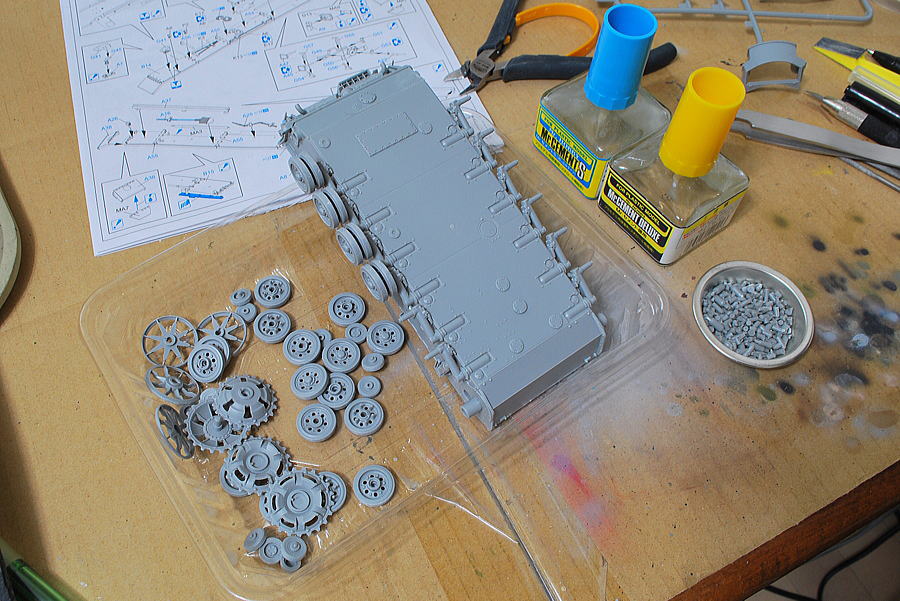 例によって細かい部品を取り付けていきます。右の塗料皿に入っているランナーの切れ端は特に意味はありません。
例によって細かい部品を取り付けていきます。右の塗料皿に入っているランナーの切れ端は特に意味はありません。
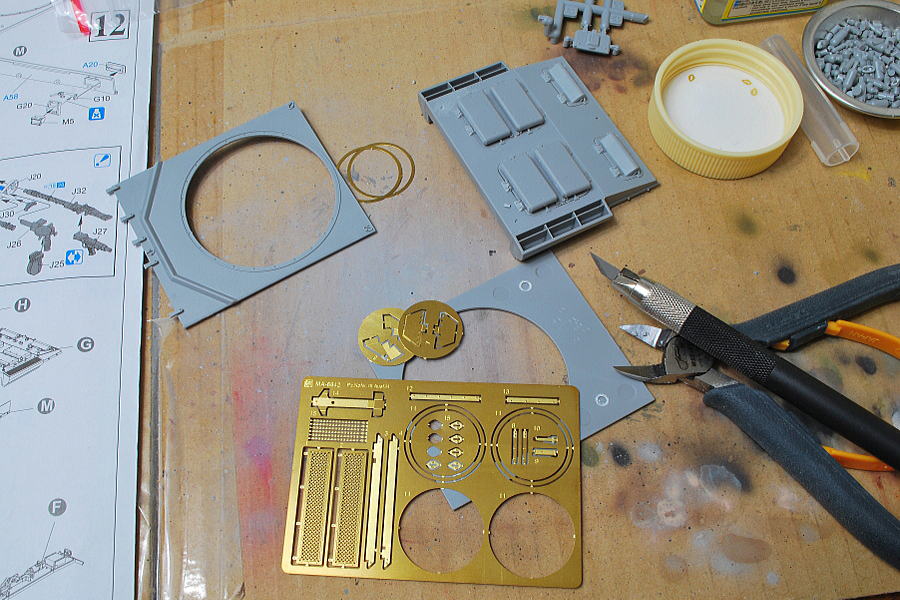 ドラゴンの説明書は間違いが多いのでパーツ形状と部品番号が違う部分がたくさんあります。多少間違えても完成できないというわけでもないのですが、なるべく確認しながら組んでいきます。信用の出来ない説明書ってある意味致命的なんですけど、ドラゴンの模型を今までたくさん作ってきたので少し慣れ気味です。写真の砲塔と接続する上面パーツは明らかに間違いですし、ほかにもちょこちょこ散見されます。間違えてきった大きな部品はエッチングパーツ切り出しの台座と化しました。
ドラゴンの説明書は間違いが多いのでパーツ形状と部品番号が違う部分がたくさんあります。多少間違えても完成できないというわけでもないのですが、なるべく確認しながら組んでいきます。信用の出来ない説明書ってある意味致命的なんですけど、ドラゴンの模型を今までたくさん作ってきたので少し慣れ気味です。写真の砲塔と接続する上面パーツは明らかに間違いですし、ほかにもちょこちょこ散見されます。間違えてきった大きな部品はエッチングパーツ切り出しの台座と化しました。
 ドラゴンの3号戦車系は変わった組み立て方をすると前も感じました。上部パーツは大まかに区切ってからあとで一気にシャーシと接着します。
ドラゴンの3号戦車系は変わった組み立て方をすると前も感じました。上部パーツは大まかに区切ってからあとで一気にシャーシと接着します。
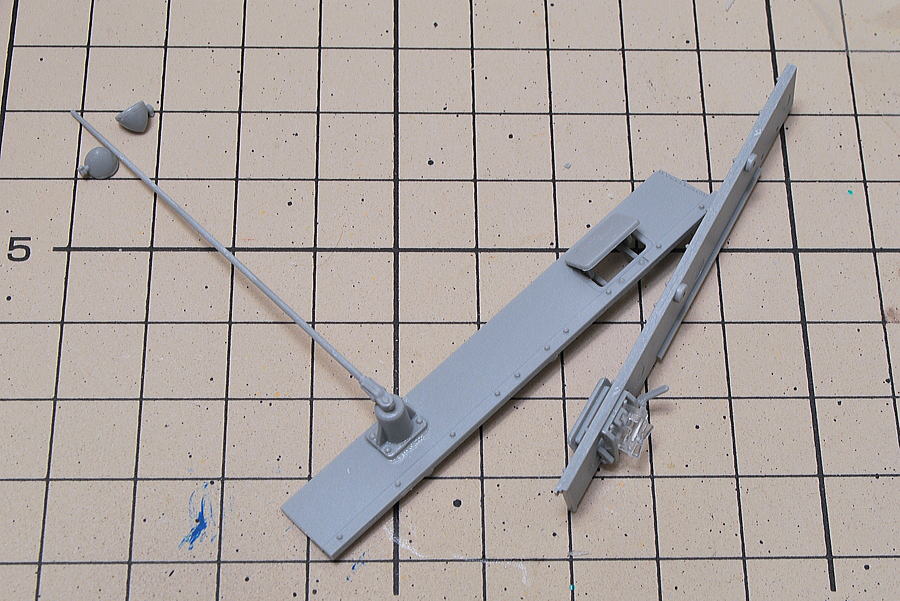 最近はワールドカップサッカーやらPCゲームにはまっていたりで模型を制作していませんでしたが、久しぶりにいじってみました。覗き窓?の内側の機構まで精密に再現してあります。
最近はワールドカップサッカーやらPCゲームにはまっていたりで模型を制作していませんでしたが、久しぶりにいじってみました。覗き窓?の内側の機構まで精密に再現してあります。
 車長ハッチの360度ペリスコープも透明部品を使っておりこだわりが感じられます。
車長ハッチの360度ペリスコープも透明部品を使っておりこだわりが感じられます。
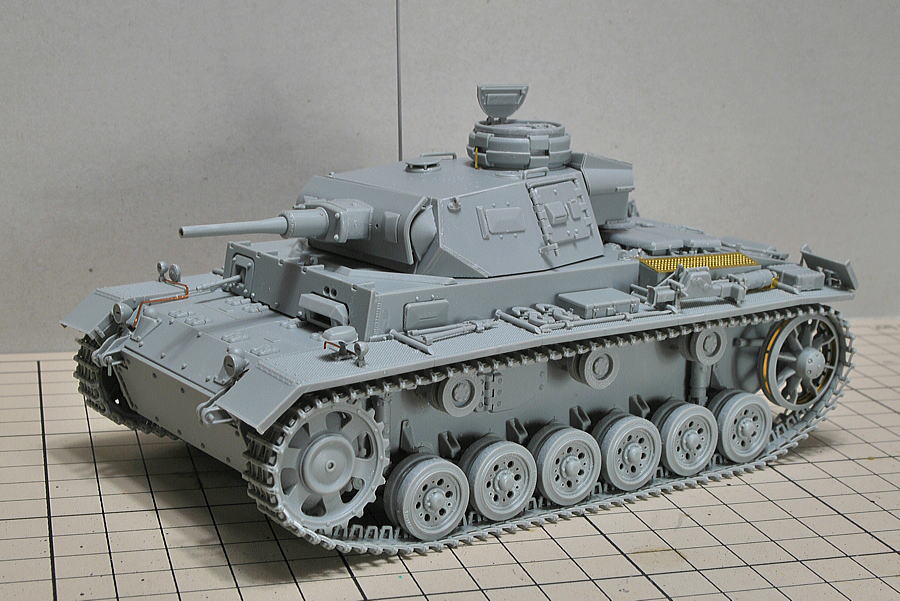 いつものことながらドラゴンのキットはランナーグループが20枚近くあり、組立が大変でした。さらにインストの難解さがハンパではなかったです。ところどころ想像で組み立てましたがそれ程大きな間違いはないかと思います。
いつものことながらドラゴンのキットはランナーグループが20枚近くあり、組立が大変でした。さらにインストの難解さがハンパではなかったです。ところどころ想像で組み立てましたがそれ程大きな間違いはないかと思います。
(2014/07/15)
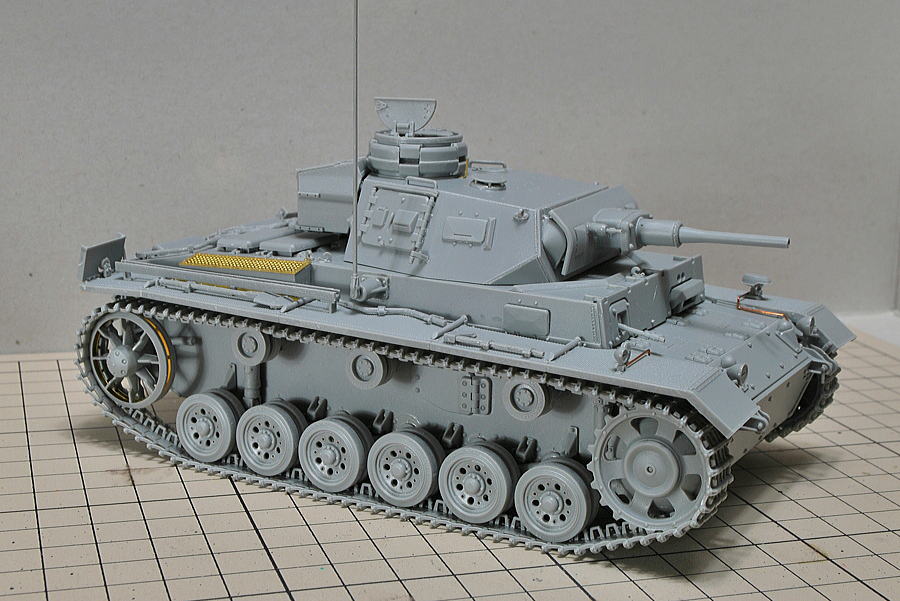 車長ハッチは可動式にしました。片側が根元を破損して可動にできなくて一箇所のみです。飾るときには固定してしまうかも。
車長ハッチは可動式にしました。片側が根元を破損して可動にできなくて一箇所のみです。飾るときには固定してしまうかも。
 ライトコードの金属線まで付けてくれて至れり尽くせりのキットです。余った部品でもう一台戦車が作れてしまうくらい不要パーツがあるのがちょっと複雑な心境です。3号戦車はいつ見てもかっこ良い。
ライトコードの金属線まで付けてくれて至れり尽くせりのキットです。余った部品でもう一台戦車が作れてしまうくらい不要パーツがあるのがちょっと複雑な心境です。3号戦車はいつ見てもかっこ良い。
(2014/07/15)
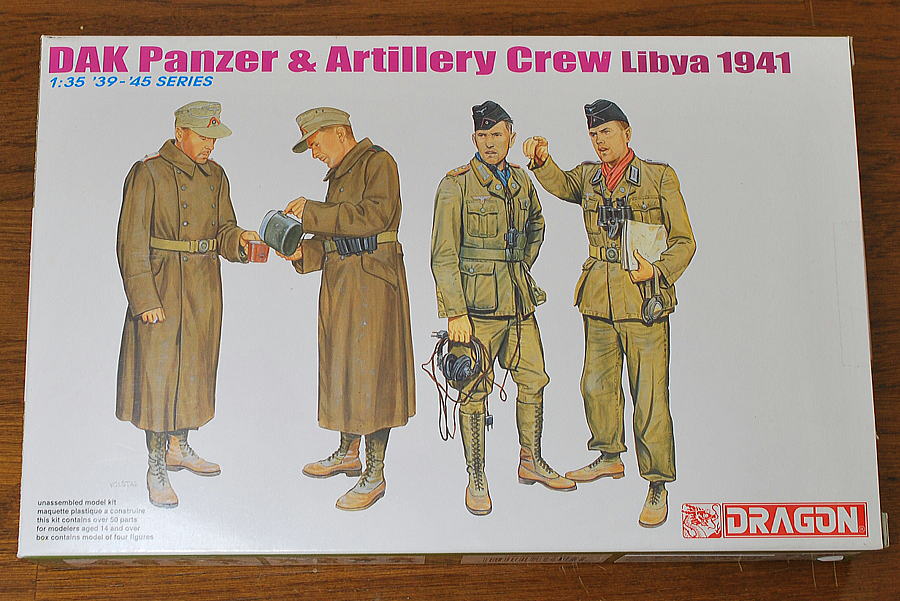 以前、砲兵を2体作ったドイツアフリカ軍団の砲兵戦車兵キットの戦車兵分がまだあるので組んでみることにしました。
以前、砲兵を2体作ったドイツアフリカ軍団の砲兵戦車兵キットの戦車兵分がまだあるので組んでみることにしました。
 略帽の頭部へのフィット感が2体ともいまいちなのであとでパテ埋めしておきます。プロポーションは自然ですが右の兵士は割りとがたいが良いほう。
略帽の頭部へのフィット感が2体ともいまいちなのであとでパテ埋めしておきます。プロポーションは自然ですが右の兵士は割りとがたいが良いほう。
 パテで増毛しました。 地図帳か作戦帳のような冊子を持っている兵士は、その断面部分をけがいて本のような雰囲気を出しました。両名とも表情はけっこう良いです。ドラゴンフィギュアの中では題材とモールドの両方を気に入ったキットです。
パテで増毛しました。 地図帳か作戦帳のような冊子を持っている兵士は、その断面部分をけがいて本のような雰囲気を出しました。両名とも表情はけっこう良いです。ドラゴンフィギュアの中では題材とモールドの両方を気に入ったキットです。
(2014/07/16)
 毎日暑くてシンナーが自然発火するんじゃないかと思うくらいです・・・。ペットのウサギは隣の冷房が効いた部屋で熟睡中ですが、自分は窓を全開にしてとりあえずサーフェイサーを吹きました。
毎日暑くてシンナーが自然発火するんじゃないかと思うくらいです・・・。ペットのウサギは隣の冷房が効いた部屋で熟睡中ですが、自分は窓を全開にしてとりあえずサーフェイサーを吹きました。
(2014/08/02)
 いったんラッカー塗料のジャーマングレーを全体に吹きました。
いったんラッカー塗料のジャーマングレーを全体に吹きました。
(2014/08/02)
 今回は巷でいろいろと流行っているエアスプレー技法なるものを試してみようと思います。当初ジャーマングレーで塗装されて、上からダークイエローを塗ったけれど部分的に剥がれたという表現をやってみます。エアスプレー技法を簡単に説明しますと、ラッカー塗料、ヘアスプレー、水性塗料の順に塗膜を形成してヘアスプレーの水溶性またはアルコールに溶ける性質を利用してうえの塗膜を崩す感じです。個人的感覚ですが水で擦ると塗膜を崩す、アルコールシンナーで溶かすと文字通り溶かすという感覚でしょうか。もともとは水性塗料しか流通していないヨーロッパのモデラーが始めたようです。
今回は巷でいろいろと流行っているエアスプレー技法なるものを試してみようと思います。当初ジャーマングレーで塗装されて、上からダークイエローを塗ったけれど部分的に剥がれたという表現をやってみます。エアスプレー技法を簡単に説明しますと、ラッカー塗料、ヘアスプレー、水性塗料の順に塗膜を形成してヘアスプレーの水溶性またはアルコールに溶ける性質を利用してうえの塗膜を崩す感じです。個人的感覚ですが水で擦ると塗膜を崩す、アルコールシンナーで溶かすと文字通り溶かすという感覚でしょうか。もともとは水性塗料しか流通していないヨーロッパのモデラーが始めたようです。
目の前にイオンがあるので早速、ヘアスプレーを購入してきました。ケープなどいろいろと在庫がありましたが安くてたくさん入っているトップバリューものにしちゃいました。サービス増量らしいですが模型には使い切れそうもありません。いま、短髪なので本来の用途には不要だし、そもそも女性用でしょうね、香りなんかも。
全体に吹いたら少しつやが出ています。
(2014/08/02)
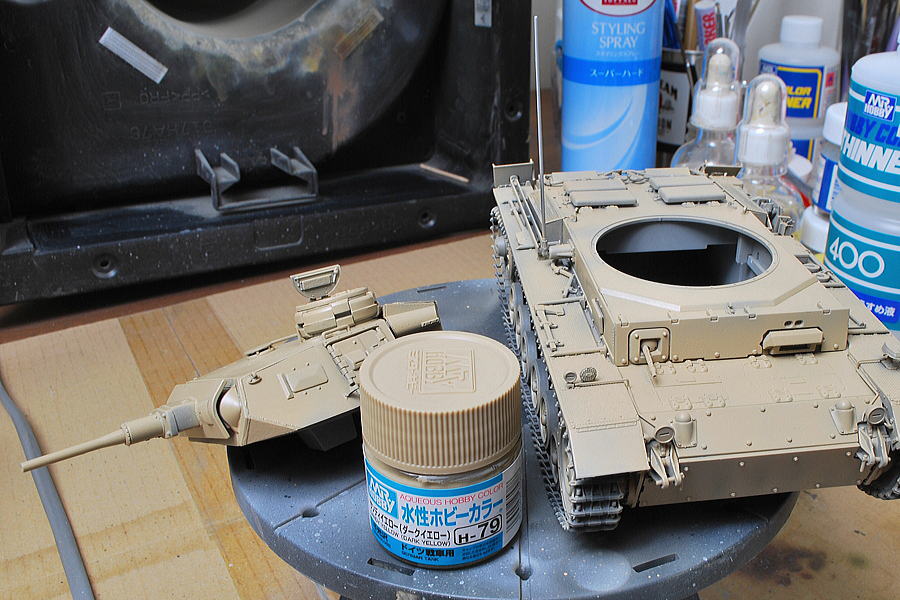 それでその上から水性ホビーカラーのダークイエローを塗装しました。水性塗料を扱うのは10年ぶりくらいです。一時期ハンブロールエナメルに凝ったこともありましたが今はラッカー塗料が好きですね。実は水性塗料はなんかベトついた感じがしてあまり好きでないのですが発色はなかなか良いです。
それでその上から水性ホビーカラーのダークイエローを塗装しました。水性塗料を扱うのは10年ぶりくらいです。一時期ハンブロールエナメルに凝ったこともありましたが今はラッカー塗料が好きですね。実は水性塗料はなんかベトついた感じがしてあまり好きでないのですが発色はなかなか良いです。
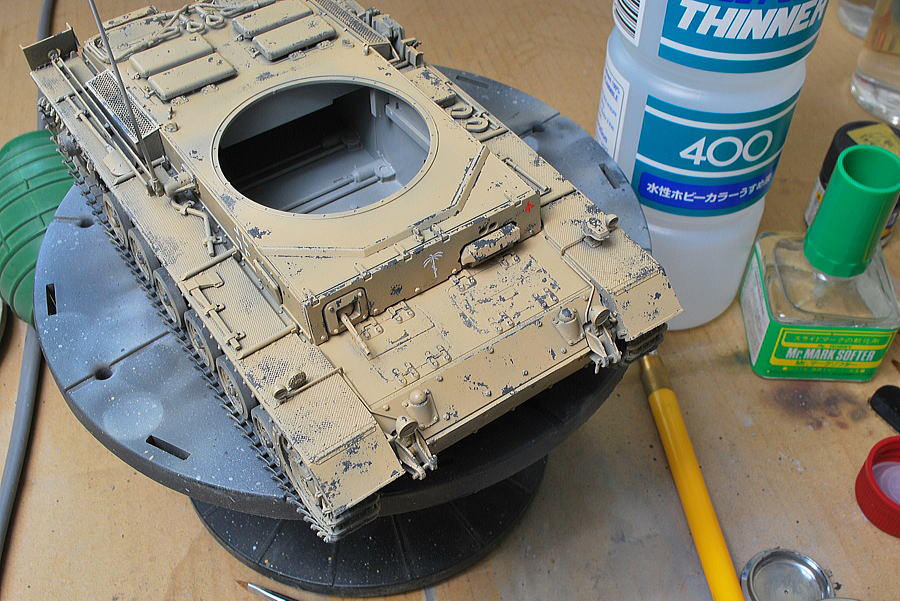 塗料剥がしは水をつけて少しずつ行いました。割と良い感じに不規則感が出たかと思います。けっこう面白く剥がれるのでやりすぎに注意したほうが良いです。下地塗料の上にクリヤーを吹いて塗装面をいったん保護してからヘアスプレーを吹いておられる方もいます。ラッカー塗料は塗膜が丈夫なので今回はクリヤー無しでやってみました。ウォッシング等のプロセスを経てもう少し味が出てくると良いのですが。
塗料剥がしは水をつけて少しずつ行いました。割と良い感じに不規則感が出たかと思います。けっこう面白く剥がれるのでやりすぎに注意したほうが良いです。下地塗料の上にクリヤーを吹いて塗装面をいったん保護してからヘアスプレーを吹いておられる方もいます。ラッカー塗料は塗膜が丈夫なので今回はクリヤー無しでやってみました。ウォッシング等のプロセスを経てもう少し味が出てくると良いのですが。
(2014/08/02)
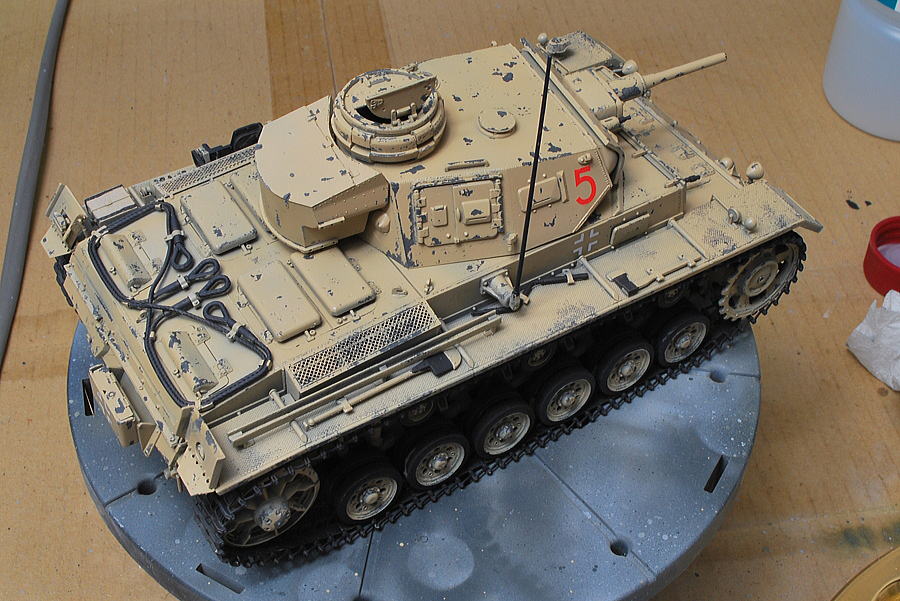 砲塔のヘアスプレー技法を使用した塗装も完了しました。装備品の基本塗装もだんだん進み、もう少しで完成です。
砲塔のヘアスプレー技法を使用した塗装も完了しました。装備品の基本塗装もだんだん進み、もう少しで完成です。
(2014/08/04)
 戦車兵もざっくりと塗り進めています。最終的には北アフリカの砂漠で戦っていることを考慮して、もう少し粉っぽく埃っぽく仕上げたいです。
戦車兵もざっくりと塗り進めています。最終的には北アフリカの砂漠で戦っていることを考慮して、もう少し粉っぽく埃っぽく仕上げたいです。
(2014/08/04)
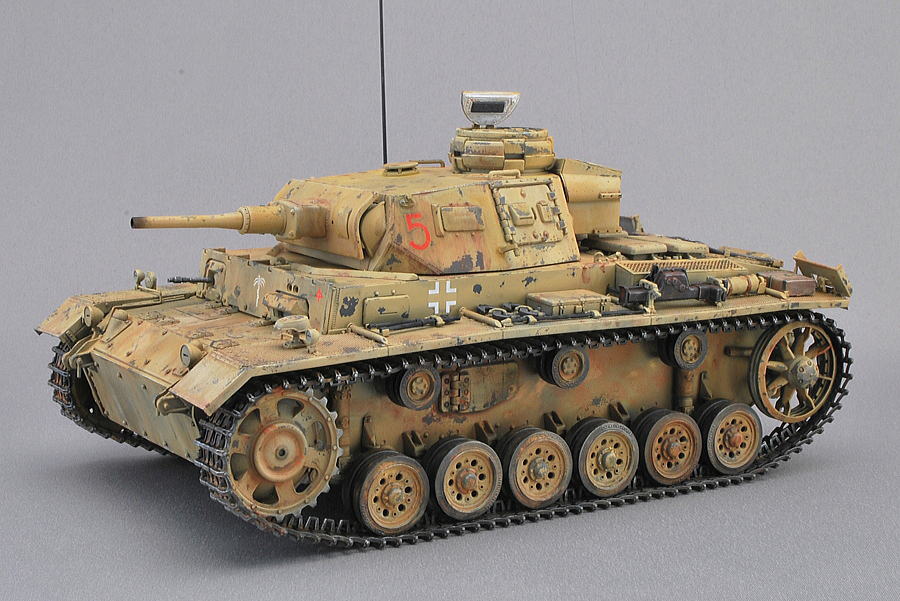 III号戦車は第二次大戦の初期から中期くらいまで活躍した主力中戦車です。形式はA型からN型までありますが、簡単に言いますとH型は42口径5cm砲搭載で増加装甲をつけたものです。H型は約300両生産されました。
III号戦車は第二次大戦の初期から中期くらいまで活躍した主力中戦車です。形式はA型からN型までありますが、簡単に言いますとH型は42口径5cm砲搭載で増加装甲をつけたものです。H型は約300両生産されました。
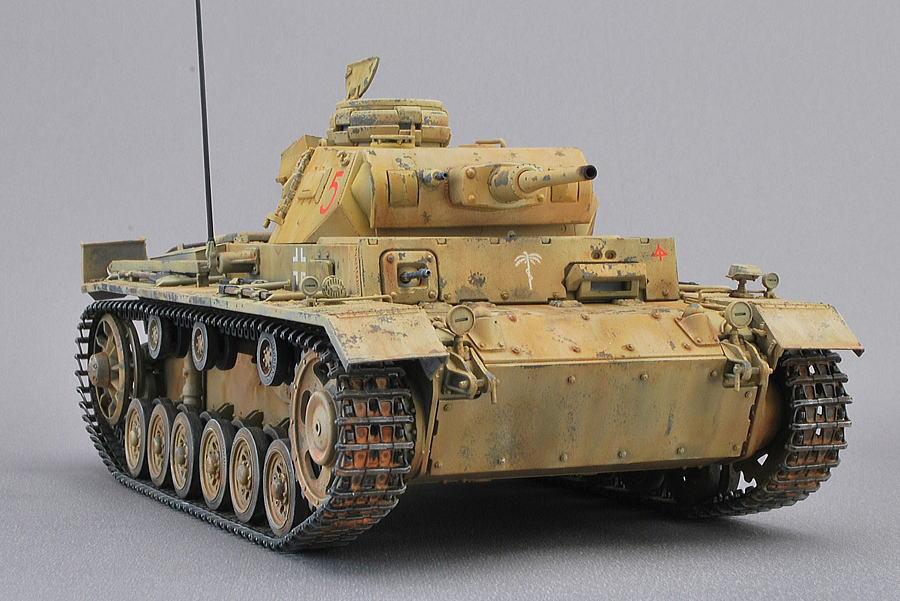 その後、長砲身化、さらに7.5cm砲へと強化され続けますが、ソ連軍との戦車開発競争が進むにつれてIII号戦車の兵装では太刀打ちできなくなり、戦車戦の主役はパンター、ティーガーI、ティーガーIIに変わっていきます。
その後、長砲身化、さらに7.5cm砲へと強化され続けますが、ソ連軍との戦車開発競争が進むにつれてIII号戦車の兵装では太刀打ちできなくなり、戦車戦の主役はパンター、ティーガーI、ティーガーIIに変わっていきます。
 ソ連軍のT-34と戦闘を交えることも多かったですが、攻撃力防御力とも上回るソ連戦車に対して運用や戦術、つまり無線指揮による連携や訓練による高い戦闘能力で戦っていました。
ソ連軍のT-34と戦闘を交えることも多かったですが、攻撃力防御力とも上回るソ連戦車に対して運用や戦術、つまり無線指揮による連携や訓練による高い戦闘能力で戦っていました。
 真横から見るとワイヤーロープに塗り残しがありました。あとで修正しておかないと・・・。
真横から見るとワイヤーロープに塗り残しがありました。あとで修正しておかないと・・・。
 マーキングは第15装甲師団、第21装甲師団と同様にロンメルの下で北アフリカで激しい戦闘を経験した部隊です。椰子の木マーキングがかっこいい!
マーキングは第15装甲師団、第21装甲師団と同様にロンメルの下で北アフリカで激しい戦闘を経験した部隊です。椰子の木マーキングがかっこいい!
 木箱、というか茶色いのはジャッキ台なのですが割りとうまく塗れたかと思います。細かい筆で今回のヘアスプレー技法のような微細な塗装剥げを描きこむのは高い技術がいるので、この技法はけっこう有用と考えます。
木箱、というか茶色いのはジャッキ台なのですが割りとうまく塗れたかと思います。細かい筆で今回のヘアスプレー技法のような微細な塗装剥げを描きこむのは高い技術がいるので、この技法はけっこう有用と考えます。
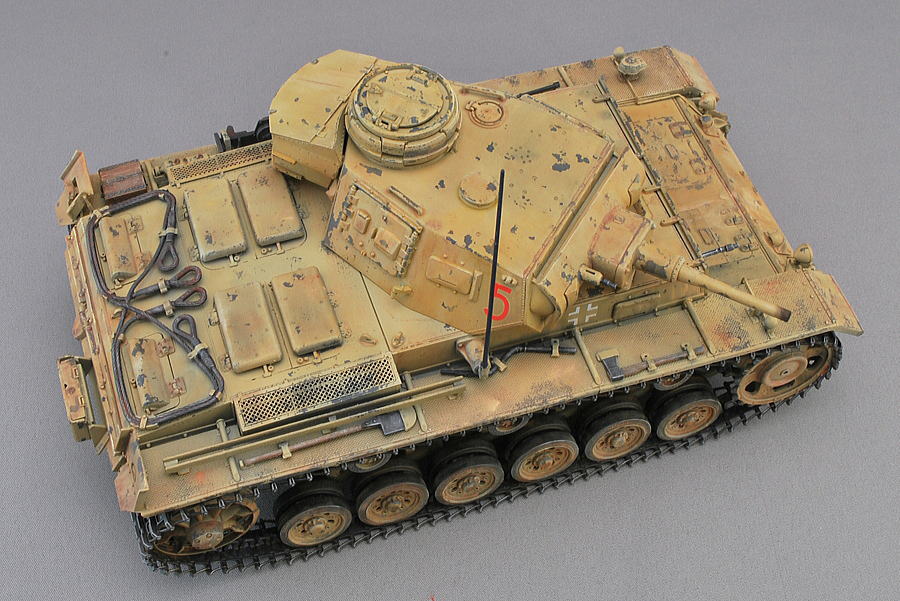 北アフリカでのドイツ軍50mm砲は大きな威力を発揮してだいたいの英軍装甲車や戦車を撃破できましたが、当事最新鋭のM3中戦車グラントが投入されると苦労しました。
北アフリカでのドイツ軍50mm砲は大きな威力を発揮してだいたいの英軍装甲車や戦車を撃破できましたが、当事最新鋭のM3中戦車グラントが投入されると苦労しました。
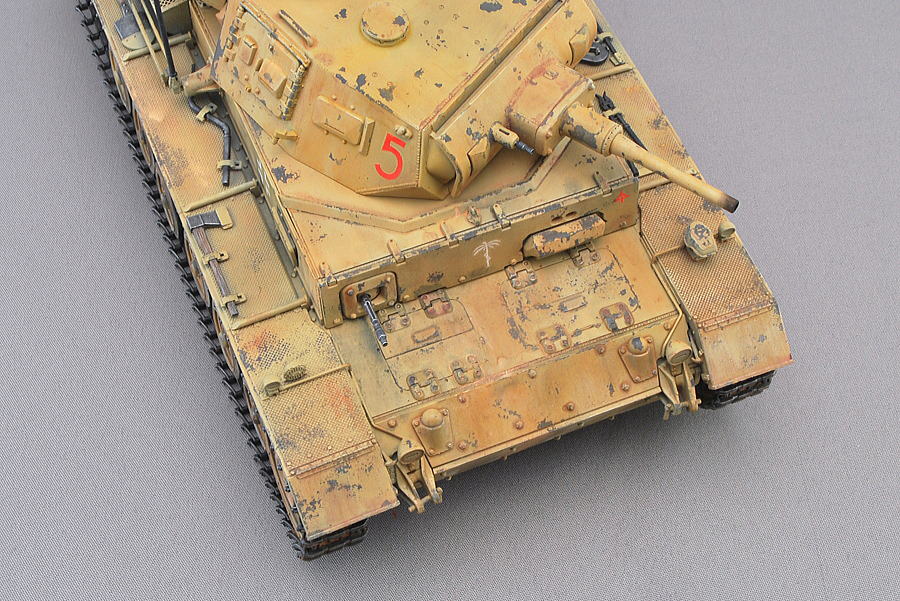 今回、ヘアスプレー技法を試してみました。ジャーマングレーの下地をランダムに露出させることで不規則な塗装剥げを演出してみました。ウォッシングをしているうちにクッキリ感が少しソフトに変化してしまうようです。全体的に調和したと見るかボケてしまったと見るか。あまり塗装剥げあとだけが目立っても不自然なのでこれくらいでちょうど良いかと思います。
今回、ヘアスプレー技法を試してみました。ジャーマングレーの下地をランダムに露出させることで不規則な塗装剥げを演出してみました。ウォッシングをしているうちにクッキリ感が少しソフトに変化してしまうようです。全体的に調和したと見るかボケてしまったと見るか。あまり塗装剥げあとだけが目立っても不自然なのでこれくらいでちょうど良いかと思います。
 砂漠の戦車兵を2体添えてみました。右の兵士はいかにも戦い好きそうな表情をしています。左の作戦帳を持った兵士はちょっと白目が大きすぎたか。
砂漠の戦車兵を2体添えてみました。右の兵士はいかにも戦い好きそうな表情をしています。左の作戦帳を持った兵士はちょっと白目が大きすぎたか。
 一応、後姿です。ちょっと色あせた軍服のほうがベテラン戦車兵の雰囲気が出るかと思います。
一応、後姿です。ちょっと色あせた軍服のほうがベテラン戦車兵の雰囲気が出るかと思います。
 砂漠では細かい砂塵があらゆる隙間から入ってくるのでこのフィギュアのように赤や青のスカーフを首に巻いていました。
砂漠では細かい砂塵があらゆる隙間から入ってくるのでこのフィギュアのように赤や青のスカーフを首に巻いていました。
 4-5cm位のフィギュアです。試しにジッポーライターを横に並べてみました。
4-5cm位のフィギュアです。試しにジッポーライターを横に並べてみました。
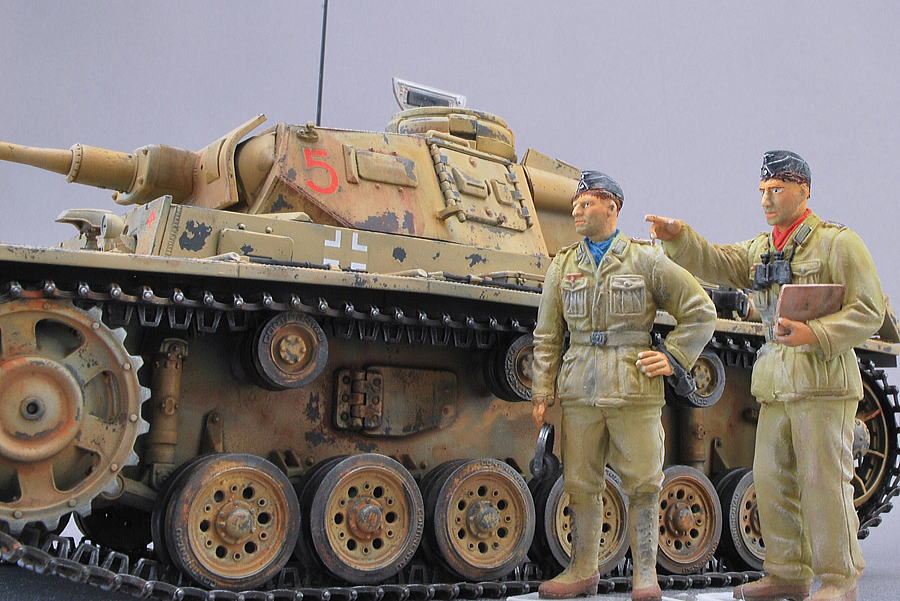 実際、等身大目線で少し見上げるとこんな感じでしょうか。ハッチまでよじ登るのけっこう大変そうです。北アフリカだと鉄板もハンパ無く熱いでしょうし。スカーフの赤と青がアクセントとしてはなかなか良い感じです。
実際、等身大目線で少し見上げるとこんな感じでしょうか。ハッチまでよじ登るのけっこう大変そうです。北アフリカだと鉄板もハンパ無く熱いでしょうし。スカーフの赤と青がアクセントとしてはなかなか良い感じです。
 うーん、正直なところ、うまくいった部分もあればもっと手を入れないと、という部分も多く、なかなか100点満点の出来にはなりません。写真を撮ると製作中ではまったく気がつかなかった部分もよく解かったりします。頭の中の完成度はもっと高いのですが手が追いついてないです。
うーん、正直なところ、うまくいった部分もあればもっと手を入れないと、という部分も多く、なかなか100点満点の出来にはなりません。写真を撮ると製作中ではまったく気がつかなかった部分もよく解かったりします。頭の中の完成度はもっと高いのですが手が追いついてないです。
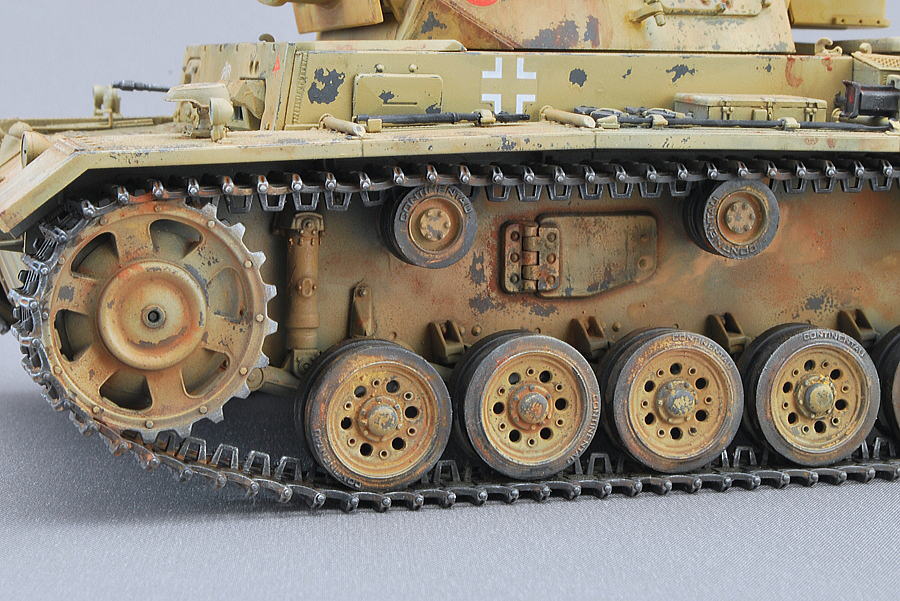 シャーシの側面はけっこうのっぺりしていて単調なので塗装で少し変化を出しました。金属のこすれあう部分は軽くメタリックでドライブラシ。
シャーシの側面はけっこうのっぺりしていて単調なので塗装で少し変化を出しました。金属のこすれあう部分は軽くメタリックでドライブラシ。
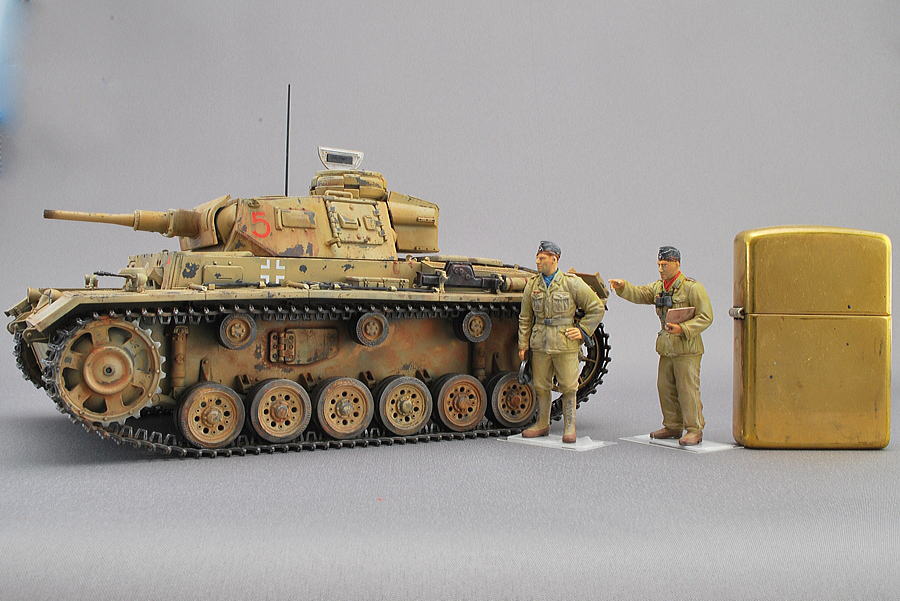 小ぎれいな仕上げを心がけたのですがウェザリングの加減が難しいです。以前作ったIII号戦車より満足度と達成感ともに高いかな。まだまだ改良点が多いですけれど全体的にはすごくかっこ良い!フィギュアはインジェクションでもけっこう表情豊かに仕上がったのは収穫でした。
小ぎれいな仕上げを心がけたのですがウェザリングの加減が難しいです。以前作ったIII号戦車より満足度と達成感ともに高いかな。まだまだ改良点が多いですけれど全体的にはすごくかっこ良い!フィギュアはインジェクションでもけっこう表情豊かに仕上がったのは収穫でした。
今度、たまには航空機のプラモデルでも作ってみようかなぁ。
(2014/08/09)




コメント